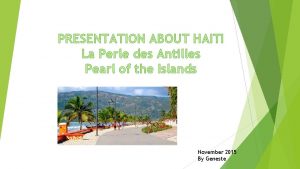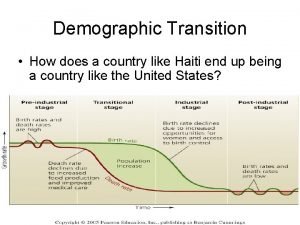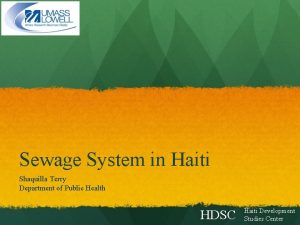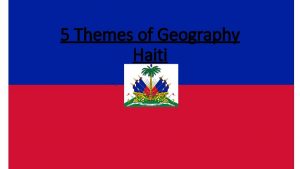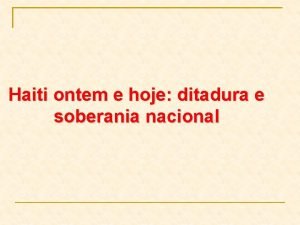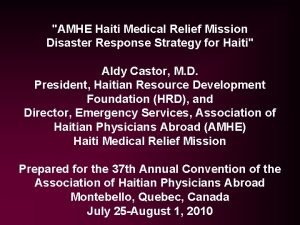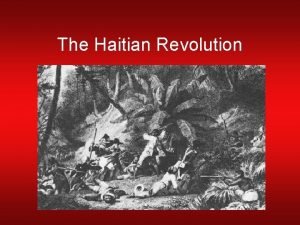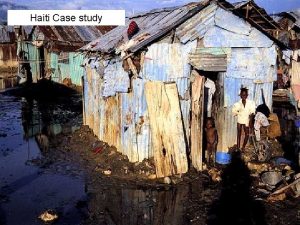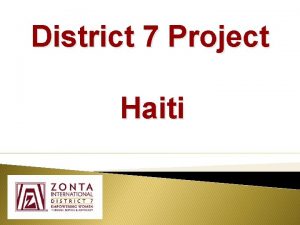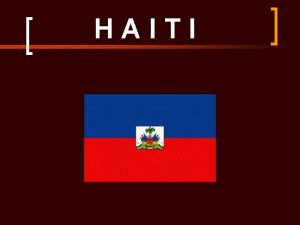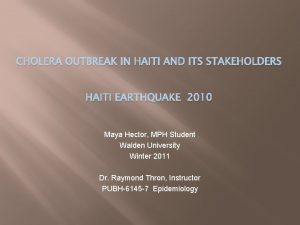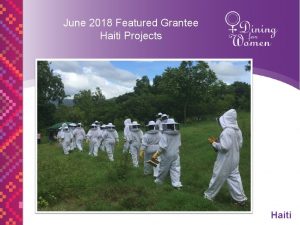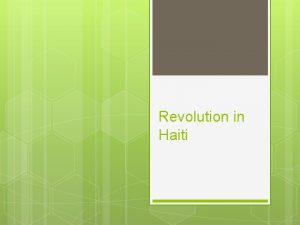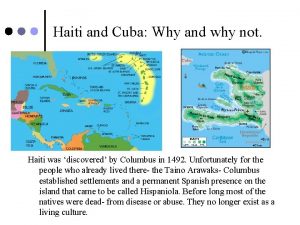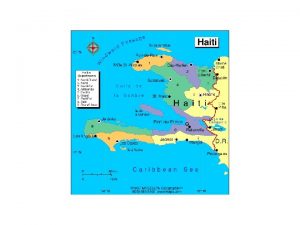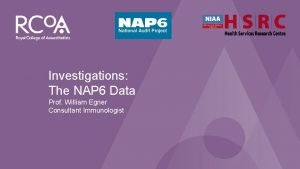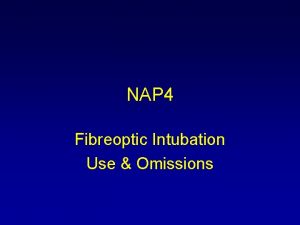Haiti Open NAP a study case REGIONAL T



















- Slides: 19

Haiti Open NAP: a study case REGIONAL T RAINING WO RK SHO P ON NAPS FOR LAC COUNTRIES 4 TO 7 S EP TEMBER 2017 SAN JOS E, C OSTA RIC A

A. 1 Launching the NAP Process § Interest of the NAP Process as a framework for adaptation options and strategies § Ministry of Environment and Ministry of Planning, with UNDP support § Create a national vision, and a Mandate : NAP has to be a development planning tool § Support accessed : Funding with GCF and UNDP Human Resources: MDE, MPCE Technical resources: UNDP (Global Support) § Define the strategy and a roadmap: ongoing.

A. 2 Stocktaking: existing institutions § Ministry of Environment (MDE), focal point for the CCNUCC and in charge of environment/climate institutions o Limited human and financial resources § Ministry of Planning and External Cooperation (MPCE) § National System for Risks and Disasters Management § Ministry of Economy and Finance (MEF) § Haitian Institute of Statistics and Information (IHSI) § The Inter Ministerial Committee for Regional Planning {CIAT / (interministerial institutional mechanism)}

A. 2 Stocktaking: existing documents § NAPA (2006): not enough to address many climate related risks and vulnerabilities, such as ecosystem degradation and demographic issues § The Climate Change National Policy (2016) § NDC (2015) § National Communications (2001, 2013) § Strategic development Plan of Haïti (PSDH) (2012): reference document for Haitian development § National progress report on the implementation of the Hyogo Framework for Action (2011 -2013) § PNGRD (2001) being updated taking into account Adaptation to Climate change § Draft du the National territorial development scheme (finalized 2017) § National Housing and Habitat Plan (Plan National de logement et de l’Habitat) - PNLH, 2012 § PAN-LCD against desertification

A. 2 Climate Change impacts Observed § Increase in period of droughts § Changes in water regimes § Losses of human lives § Reduction in available freshwater § Increased erosion

A. 2 Climate Change impacts Expected: § Increase in Temperatures (+0. 8 -1˚C by 2030, +1. 5 -1. 7 ˚C by 2060) § Decrease in annual rainfalls (from -6% to -20% by 2030) § Change in water regimes, hydrology § Sea Level Rise § Decrease in Ecosystem Services and changes in biodiversity § Potential progress in wood production, and increase in heatwaves and wild fires on forests Estimated costs without preventive measures by 2025 : 1. 8 billion USD (with: 77 million USD)

A. 2 Vulnerabilities Exposure: § On the trajectory of tropical hurricanes. From all Caribbean countries, Haiti is the one suffering form the biggest number of disasters/km² Sensitivity: § Weak economic resilience capacity, whose vulnerability to climate change impacts is increasing. o 50% of the national budget is dependent on foreign aid o A hurricane could cause up to 10% loss of GDP (MDE/MEF (Carbonium) 2015) o 2008: hurricanes and tropical storms: 15% GDP § Structural poverty: 59% of Haitian live below the poverty line

A. 2 Vulnerabilities Sensitivity : § Agriculture is the first provider of jobs, and one quarter of GDP (17% secondary sector, 55% tertiary in 2015). o 60% of food needed food is imported. o Half of the population live in rural areas, whose 85% of this population is farming; § Weak ecosystems § Weak health systems § High demographic growth § Construction in vulnerable zones and migration § West, North-West, South, Nippes, Centre and South East most vulnerable departments § Weak adaptive capacity: little funding for adaptation (MDE/MEF (Carbonium) 2015), regardless of the substantial development aid provided

A. 2 Expected impacts per sector § Biodiversity: wetlands may not be able to cope with sea level rise, likewise with coastal lagoons, floodplains. § Agriculture: loss of land, loss of production (salinization, floods, more invasive plants, modified ecology of weedy plants, pests, increasing need of water of maize, loss of cattle) , lower productivity (Temperature increase) § Infrastructure: Destruction of tourism infrastructures, roads, electricity and water networks, loss of values of flooded zones, energy and water networks (indirect loss) § Basic social services : education, water access and sanitation, electricity § Productive system/Economy: § Habitat, etc

Case study on an extreme event: Hurricane Matthew § 4 th of October 2016: floods (more than 600 mm in less than 24 h); storm waves; temporary Sea Level Rise: 1 to 3 m § Immediate response: international and regional aid § Need for institutional framework, participatory approach with all stakeholders, focus on economic revitalization and social services reestablishment § Global costs: 2. 778 billion USD, whose ¾ are burdened by the affected population (private costs) § Entire sectors of the economy to rebuild, for example irrigation systems, production and agro -transformation units for 428 000 farmers. § But on the long term, adaptation needs: increase resilience of those sectors and the public policies

A. 2 Planned adaptation options (NDC, PANA etc. ) § A lot of adaptation options and strategies are not implemented yet § Priorities o Integrated water resources and watershed management o Integrated management of coastal zones and infrastructure rehabilitation o Enhancement and Preservation of food security o Information, Education and Awareness-Raising § Many Commitments (NDC 2015) § Funding, three approved LCDF projects o Strengthening resilience in Agriculture to improve food security in Haiti post-earthquake o Increasing resilience of ecosystems and vulnerable communities to CC and anthropic threats through a ridge to reef approach to BD conservation and watershed management o Resilient Productive Landscapes in Haiti

A. 2 Existing adaptation measures (examples) § Within the PANA, measures regarding water resource protection, coastal zones management, food security enhancement § Ex: Completed LCDF project (UNDP implementing agency): Strengthening Adaptive Capacities to Address Climate Change Threats on Sustainable Development Strategies for Coastal Communities in Haiti (2013) o 21 management committees supported, and 8 new for watershed, which support reforestation, awareness raising, etc. o More than 267 000 mangrove trees planted o Awareness raising on climate change and other environmental stakes radio emissions, door to door (12000 visits/month), community participation o Training of 23 members in the project o 50 trained agents for vulgarization on resilient agriculture

A. 2 Existing adaptation measures (examples) § Other initiatives form the civil society AYITIKA initiatives in partnership with the Ministry of Agriculture promoting cacao production in agro-forestry systems in the South, raising awareness and sharing knowledge on climate-related issues and on research development. § AP 3 C Project, financed by Europ. Aid: climate-smart agriculture § FAO project : Strengthening Climate Resilience and Reducing Disaster Risk in Agriculture to Improve Food Security in Haiti post-Earthquake (LCDF): 2013 -17 (completed )

A. 3 Identified Gaps and Needs § Lack of information on climate change impacts § Weak institutional capacity § Limited financial resources § Lack of information on existing adaptations strategies and options and their success.

A. 4 Development Context § Plan stratégique de développement d’Haiti (PSDH) (2012): reference document for Haitian development o Nine lines of action for environment: Improving environmental governance, vulnerability reduction of the poorest and adaptation to CC, better urban management, integrated water resources, watershed and coastal zones management, country reforestation and seek for equilibrium between supply and demand for wood, fight against land degradation and improved biodiversity management, fight against pollutions, monitoring of environment, Setting the environment as a space for investment and business opportunities § NAPA (2006) § PAN-LCD against desertification § PNGRD (2001) being updated taking into account Adaptation to Climate change § Draft du schema national d’aménagement du territoire (ongoing 2017) § Climate Change National Policy (2016) § Plan national de logement et de l’Habitat (PNLH, 2012)

Elements B. 1 and B. 2: Where to begin ? §Vulnerability and Risk assessment: a coastal surveillance and early warning system for adaptation to climate change has been designed, and comprises a physical vulnerability map. o Different scenarios of climate change have been used o Key findings: 21 000 acres of land are threatened by marine intrusion (7% of the national irrigated area), Artibonite, North East, North mostly threatened. §Vulnerability assessment in the NAPA (see A. 2) §Vulnerability assessment of coastal areas in the UNDP-LCDF funded project

B. 3 Key Considered Adaptation Options § Agriculture : Diversification of cultures within systems such as agro-forestry, etc. . . § Early warning systems § Biodiversity: Protected Areas Settlement on Mangroves, restoration of wetlands, reduce pollutions § Watershed, water resources, waste, . . . : Have an integrated management, prevent damages §. . . Use the existing documents and the pre-project studies !

-NAP program/roadmap -GCF readiness program -Progress Report THE NAP ROADMAP NAP 2018 2017 ELEMENT A INPUITS 2001: National System of risk management 2002: National Communication 1 2006: NAPA 2007: Strategic Development Plan of Haiti 2020 2019 ELEMENT B ELEMENT C 2015 NDC 2013: National Communication 2 Other Vulnerability and Risk Assessments For ex. coastal surveillance and early warning system for CCA Climate Models Data All planned and existing Adaptation and Disaster Risk Management Options & Strategies: In which parts of the NAP could they fit ? ELEMENT D

Example of institutional framework for the process to formulate and implement NAP in Haiti
 Open nap
Open nap Open innovation open science open to the world
Open innovation open science open to the world Best case worst case average case
Best case worst case average case Crm failure case study
Crm failure case study Liste des ophtalmologues d' haïti
Liste des ophtalmologues d' haïti Lagonav
Lagonav When did yole derose die
When did yole derose die Oge haiti
Oge haiti Haiti dtm stage
Haiti dtm stage Spih
Spih Effluent pumps haiti
Effluent pumps haiti Rev cafe haiti
Rev cafe haiti Absolute location of haiti
Absolute location of haiti Haiti
Haiti Mc donald haiti
Mc donald haiti Gerdameria
Gerdameria Haiti
Haiti Bailes tipicas de honduras
Bailes tipicas de honduras Haiti
Haiti Haitian revolution map
Haitian revolution map






